I was replying on the Southwest Fare thread and got carried away on a tangent. This subject really deserves its own thread.
I skied N VT a lot. I miss it, despite being in the west now with access to the Sierra. IMHO N VT has the best trees and the best tree skiers in North America. I am always meeting Californians who have never been there who say the east is nothing but ice. I grin and tell them, ”˜well, you shouldn’t go there.’ What makes the trees so good? Conifers mixed with several different species of hardwoods. It’s less predictable and more challenging than a single dominant species. The lines have been ”˜gardened ”˜ for 50 years or more by good skiers who trim the saplings and undergrowth with hand tools only. There are unwritten rules that are generally respected so as to minimize the impact. Nothing over 1 inch diameter is cut. And never, never cut anything above ground level. That leaves pungi traps in winter. Mad River has a credentialed forester who leads and instructs summer trail workers, who are all volunteer skiers, not resort employees. The the epicenter of this culture lies in N VT; MRG, Sugarbush, Stowe, Smuggs, Jay, Bolton. It is accepted there, by the patrol, the locals and resort management, so long as you keep it below the radar. (See unwritten rules, above.). You do not enter or leave the woods when being observed by others, especially young people. You are supposed to have a partner. Many don’t, but are willing to accept the risk, and would never, as a point of honor, blame the resort if they came to grief. Those who cut lines in the woods follow a strict protocol. The entrance must be well hidden behind a rock or tree. There should be an entrance exam, typically 3-6 feet of mandatory air to keep out those who don’t belong. There must not be anything more demanding than the entrance exam, lest people be marooned deep in the Woods.
My daughter and family lived in Burlington for 15 years, had their pass at MRG, and the 3 grandsons were on the free ski team. I learned the culture and my B- tree skiing skills from them and their friends. The best of the tree skiers there are amazing. One told me that he skis by the Jedi method - believe and the opening will appear when you get there. Here is a great example.
and, thanks to Rob Davis for encouragement and title.
Denis, I went to start a new thread with this title right after I PMed you. I just about had my post completed and I accidently brushed my touch screen, hitting the back button that wiped out the post. Oh well, get back to it later, I thought. I logged on and saw your post with the same name and I thought, maybe I did post the thread. I was particularly interested in the 50 years of gardening that is needed to ski the eastern hardwood forest slalom. Tree skiing, Eastern style, began with Perry Merrill, Charlie Lord and the CCC on Mt. Mansfield in 1938, 2 years before the first chairlift. The first cut glades were cleared on skiers left of the Nosedive trail originally call Slalom Glades now on the map as Nosedive Glade, it is one of the few glades at Stowe that is marked on the trail map. Stowe, unlike their neighbor to the north, Jay Peak, chooses not to mark all their glades on the trail map. The culture that Denis describes is alive and well at Stowe and Mad River Glen. Finding tree runs require a bit more adventure than looking at a trail map there.
It is getting late but I want to tell some tales of how I came to discover the thrill of skiing in the trees and how we are continuing the tradition of user pruned tree skiing at Laurel Mountain. I'll post more later,
Denis wrote:
I was replying on the Southwest Fare thread and got carried away on a tangent. This subject really deserves its own thread.
I skied N VT a lot. I miss it, despite being in the west now with access to the Sierra. IMHO N VT has the best trees and the best tree skiers in North America. I am always meeting Californians who have never been there who say the east is nothing but ice. I grin and tell them, ”˜well, you shouldn’t go there.’ What makes the trees so good? Conifers mixed with several different species of hardwoods. It’s less predictable and more challenging than a single dominant species. The lines have been ”˜gardened ”˜ for 50 years or more by good skiers who trim the saplings and undergrowth with hand tools only. There are unwritten rules that are generally respected so as to minimize the impact. Nothing over 1 inch diameter is cut. And never, never cut anything above ground level. That leaves pungi traps in winter. Mad River has a credentialed forester who leads and instructs summer trail workers, who are all volunteer skiers, not resort employees. The the epicenter of this culture lies in N VT; MRG, Sugarbush, Stowe, Smuggs, Jay, Bolton. It is accepted there, by the patrol, the locals and resort management, so long as you keep it below the radar. (See unwritten rules, above.). You do not enter or leave the woods when being observed by others, especially young people. You are supposed to have a partner. Many don’t, but are willing to accept the risk, and would never, as a point of honor, blame the resort if they came to grief. Those who cut lines in the woods follow a strict protocol. The entrance must be well hidden behind a rock or tree. There should be an entrance exam, typically 3-6 feet of mandatory air to keep out those who don’t belong. There must not be anything more demanding than the entrance exam, lest people be marooned deep in the Woods.
My daughter and family lived in Burlington for 15 years, had their pass at MRG, and the 3 grandsons were on the free ski team. I learned the culture and my B- tree skiing skills from them and their friends. The best of the tree skiers there are amazing. One told me that he skis by the Jedi method - believe and the opening will appear when you get there. Here is a great example.
and, thanks to Rob Davis for encouragement and title.
Denis, I can vouch that both JohnL and Scott (SCWVA) are both Jedi as I have heard them both say almost exactly that too many times to count in my years skiing with them at Timberline.
There is an active thread on AlpineZone related to this same topic right now: http://forums.alpinezone.com/showthread.php/139997-Is-powder-tree-skiing-in-the-east-overrated
I am not the greatest tree skier, but I have grown to like what I think some folks call glade skiing - that is semi-open areas with dashes of trees. These are places I can manuever in and they still often hold better snow than groomers and regular designated runs. This kind of semi-open terrain is more common out west, and that is where I have done a bit of it. Skiing offpiste allows you to explore a whole mountain instead of just cut trails. I really admire folks who are nimble enough to charge through tight eastern glades/trees. My skiing is not so fluid to allow me to do that and I wind up sort of picking and scratching. That Jedi mind trick sounds interesting - may the force be with you!
A few random photos of Eastern tree skiing:
marcus in pearly glades, Timberline, WV:

Rod Smith, Mineshaft Glade, Blue Knob, PA
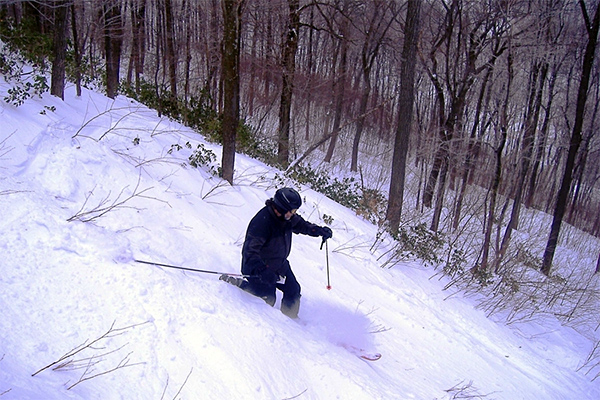 Seven Springs, PA, frontside glades:
Seven Springs, PA, frontside glades:
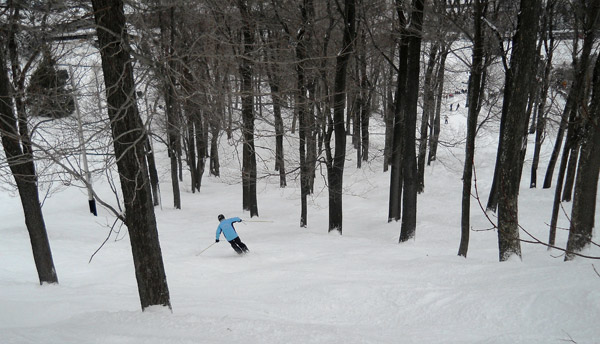 LHC in Triple Glades, Blue Knob, PA
LHC in Triple Glades, Blue Knob, PA
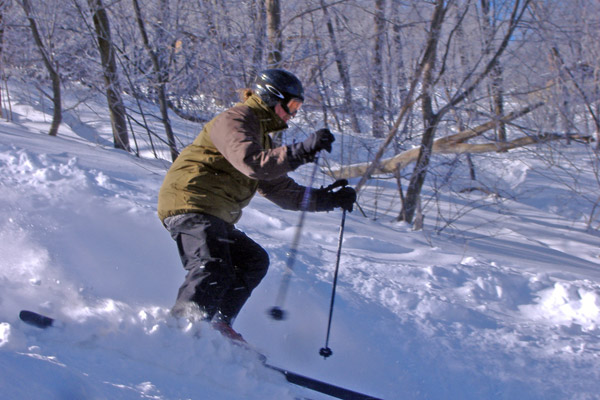 Paradise trail, Mad River Glen, VT
Paradise trail, Mad River Glen, VT
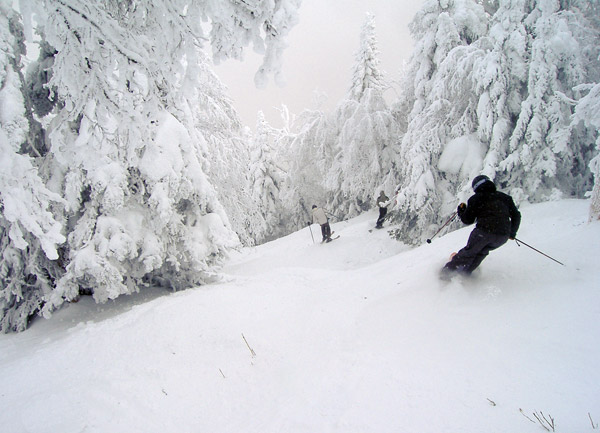 Black Forest Glades at Mont Sainte Anne, Quebec, a very large glade considering how heavily manicured it was:
Black Forest Glades at Mont Sainte Anne, Quebec, a very large glade considering how heavily manicured it was:
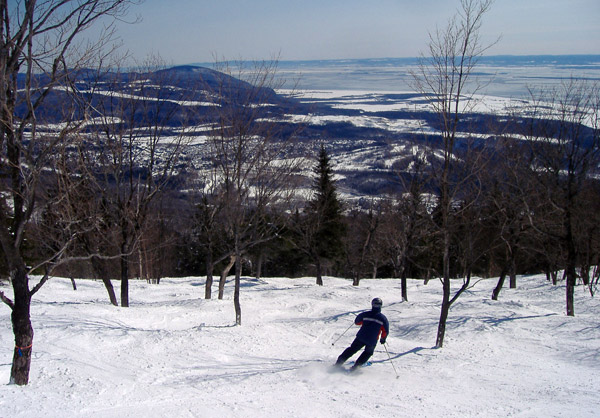 Casablanca Glades, Saddleback, ME, one of the largest and best eastern glades I've skied:
Casablanca Glades, Saddleback, ME, one of the largest and best eastern glades I've skied:
Flying Monkey Glade, Sunday River, ME:
another from Mad River Glen, VT, somewhere on lower mtn.
It first dawned on me that there was a whole other dimension of skiing beyond the groomed or bumpy trail, a place beyond the scornful eye of the 1960s era ski patrol. I was a kid just in prime 'tween years and skiing was seeming to just take off. Quite a few communities had rope tows area that would spring into operation when nature permitted. The big hills to the east were getting chairlifts and snowmaking but skiing for most was a backyard endeavor. In 1965 the county parks department decided to install snowmaking and lifts at a suburban county park, Boyce Park. It seemed to us kids that the Patrol was dedicated to ruining our fun. No sooner would we build a little kicker on the slope, and I do mean small, the Patrol would come by and knock down the jump and yell at the kids that jumping was not allowed, just like running or diving at the county swimming pool. Well, the evergreen and hardwood trees between the two trails about midway down this towering 180 foot vertical face was the perfect place to conceal a little jump, a slight downhill opening, enough to get a foot or 2 of air, surrounded by evergreens not much taller than ourselves. Soon I discovered that skiing down to the jump in the woods was even more fun than hitting the little kicker. That winter was fun but I never really gave it much thought when I went on to Hidden Valley or Seven Springs. Although I had sampled the goods, it was in such a different context. We hit the jump and zigzagged in the trees for challenge. At the bigger hills there was the challenge of steepness, length, and height to challenge one's skills.
A friend, a skier with the soul of a poet, has written a remarkable little book on the northern New England backcountry.
https://www.amazon.com/Guide-Western-Slope-Outlying-Areas/dp/1937677974
(I have no stake in this, I just think it a wonderful read.) It is written with deliberate obfuscation, which makes it much better if you’ve been to the places described. I have. The western slope refers to the west side of Mt. Mansfield where skiing started, before they built the lifts that became Stowe Mountain Resort on the east side. The first chapter is about the Bruce trail, which has been lovingly maintaIned by skiers since it was cut by the CCC in 1933. It begins behind the stone hut and ends at the Matterhorn, the best bar in Stowe. It’s a great end of day run. After a celebratory libation you take the town shuttle bus back to the ski area to return to your car. Another chapter begins with the sentence, “They built a railroad to the moon.” It refers to Mt. Washington, and specifically to Airplane Gully, a hair raising run in the Great Gulf.
If you want a real dose of tree skiing in WV, you have to go to White Grass and earn your turns. I kid you not, there are more top to bottom little tree runs and open buffed glades than ever before this year, and easily more than any resort in the mid-atl.
What happens when there is no snow to ski at WG?.... we make the trails and woods even more buff to be skiable on even less snow and have developed something called "low snow technology" :P 100's of acres of buffed manicured tree skiing await you! just add snow! :)
vid from few years back in a record breaking march.....
Ah yes, Whitegrass. It’s unique and available to all on this list within a few hours drive. (Except me now, but I’ll pobably be back given the opportunity.). Most lines, like the one Chaga showed are open enough to see your line and pitched so as to be accessible to most intermediate or above skiers. Of course the masters of this universe use skinny edge less cross country skis and bedroom slipper boots to ramp up the challenge. Chip tents wider telemark equipment as well and many of us use it. Modern tele gear supports parallel turns too; you don’t have to learn a new technique unless you want to. I’ve even seen split boards and Alpine touring gear. There are open slopes too, right above the Lodge, Springer Orchard, and the ”˜National Nordic Reserve’. Ask Chip.
the snow is better at Whitegrass than anywhere else because of the grooming. Not the snow but the bare ground. The faithful clear the slopes and glades in the fall, removing deadfall and rocks of any size, even tall spiky weeds. Join a trail crew and become one of the inner circle that knows where the goods are. You can ski Whitegrass’ glades on much less snow than off piste at TL or CV.

Join the conversation by logging in.
Don't have an account? Create one here.